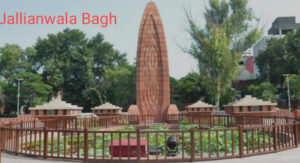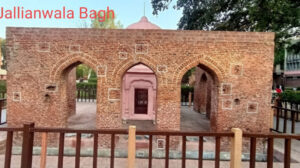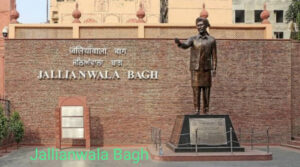Jallianwala Bagh, located in Amritsar, Punjab, stands as one of the most poignant symbols of India’s struggle for independence. This historical site, now a memorial, was the scene of a brutal massacre that occurred on April 13, 1919. The tragic events that unfolded at Jallianwala Bagh were not just a horrific act of violence but a significant turning point in India’s fight against British colonial rule. The massacre awakened a new resolve among Indians, igniting a nationwide movement that ultimately led to the end of British domination.

Jallianwala Bagh:Historical Background
The early 20th century was a period of great unrest in India. The Indian National Congress and other political groups were gaining momentum in their demand for self-rule. The First World War had placed a heavy burden on the Indian populace, with increased taxes and forced recruitment of soldiers. Amidst this tension, the British government introduced the Rowlatt Act in 1919, which allowed the colonial authorities to arrest and imprison anyone suspected of sedition without trial.
The Rowlatt Act was widely opposed across India, as it was seen as an affront to civil liberties. It led to widespread protests and strikes, particularly in the Punjab region. Amritsar, an important city in the independence movement, became a focal point of these protests. The British authorities, concerned about the growing unrest, responded with harsh measures to suppress the movement, setting the stage for the tragic events at Jallianwala Bagh.
Jallianwala Bagh: The Events of April 13, 1919
On April 13, 1919, a large crowd of men, women, and children gathered at Jallianwala Bagh, a public garden in Amritsar, to celebrate the festival of Baisakhi. Many were unaware that the British authorities had imposed martial law, banning all public gatherings. The peaceful assembly quickly turned into a scene of unimaginable horror when General Reginald Dyer, the acting military commander of Amritsar, arrived with his troops.
Without any warning, General Dyer ordered his soldiers to open fire on the unarmed crowd. The firing lasted for about 10 minutes, during which the troops, positioned at the only exit of the garden, fired relentlessly into the dense crowd. The narrow lanes and high walls of Jallianwala Bagh trapped the people inside, leaving them with no way to escape the bullets.
Official figures reported that around 379 people were killed and over 1,000 were injured, though unofficial estimates suggest that the death toll was much higher. The massacre at Jallianwala Bagh shocked the nation and the world, leaving a deep scar on the collective memory of India.

Impact on the Indian Freedom Struggle
The Jallianwala Bagh massacre had a profound impact on the Indian freedom struggle. The brutality of the act and the indifference of the British authorities to the suffering of the Indian people led to widespread outrage. For many Indians, the massacre shattered any remaining illusions of fair treatment under British rule.
Mahatma Gandhi, who had been advocating for non-violent resistance, was deeply affected by the massacre. He intensified his efforts to mobilize the Indian population against the British, leading to the launch of the Non-Cooperation Movement in 1920. The massacre also led to a shift in Indian political thought, with many moderates abandoning their loyalty to the British Crown and joining the call for complete independence.
Internationally, the massacre was condemned by leaders and intellectuals, further isolating the British government. The events at Jallianwala Bagh became a rallying point for the Indian independence movement, uniting people from all walks of life in the fight against colonial oppression.

Jallianwala Bagh Memorial
In the years following the massacre, Jallianwala Bagh was transformed into a memorial to honor the victims. The site was purchased by the Indian National Congress in 1920, and in 1951, it was officially established as a national memorial by the government of India.
The Jallianwala Bagh Memorial stands as a stark reminder of the sacrifices made by those who lost their lives in the struggle for freedom. The memorial includes a Martyrs’ Well, where many people jumped to escape the bullets, and the bullet-marked walls that bear witness to the horror of that day. The Flame of Liberty, an eternal flame, burns in memory of the victims.
The memorial also houses a museum, which displays artifacts, photographs, and documents related to the massacre. Visitors to the site can learn about the historical context of the events, the impact of the massacre, and the stories of those who were affected. The Jallianwala Bagh Memorial serves as a powerful symbol of resistance and a reminder of the cost of freedom.
Controversies and Apologies
The British response to the Jallianwala Bagh massacre was marked by controversy. General Dyer was initially lauded by some in Britain as a hero who had quelled a potential uprising, while others condemned his actions as a brutal abuse of power. The official inquiry into the massacre, known as the Hunter Commission, criticized Dyer’s actions but did not recommend any significant punishment.
The lack of accountability and the refusal of the British government to issue a formal apology for decades fueled resentment among Indians. It wasn’t until recent years that the British government began to acknowledge the atrocity more openly. In 2019, on the centenary of the massacre, British Prime Minister Theresa May expressed “deep regret” over the incident, though it fell short of a full apology.
The massacre and the subsequent British response have had a lasting impact on Indo-British relations. The events of April 13, 1919, continue to be a point of contention, with many Indians calling for a more explicit acknowledgment of guilt and a formal apology from the British government.
Legacy and Remembrance
Today, Jallianwala Bagh is remembered as a symbol of the resilience and determination of the Indian people in their fight for independence. The massacre is taught in schools across India as a crucial chapter in the nation’s history, ensuring that the memory of the victims is preserved for future generations.
Every year, on April 13, people across India observe the anniversary of the Jallianwala Bagh massacre. Commemorative events are held at the memorial, where people pay their respects to the martyrs. The site remains a place of pilgrimage for many, a solemn reminder of the sacrifices made in the pursuit of freedom.
Conclusion:
The Jallianwala Bagh massacre stands as a dark chapter in the history of British rule in India. However, it also represents a turning point in the Indian independence movement, galvanizing a nation to stand united against colonial oppression. The memorial at Jallianwala Bagh serves as a lasting tribute to those who lost their lives, reminding us of the importance of remembering history to prevent such atrocities from happening again. The legacy of Jallianwala Bagh continues to inspire and educate, ensuring that the sacrifices of the past are never forgotten.
FAQ:
1.What happened on the 13 April 1919 in Punjab?
2.What is the history of Jallianwala Bagh?
3.How many died in Jallianwala Bagh?
4.Who ordered killing at Jallianwala Bagh?
5.Jallianwala Bagh massacre date
6.Write short note on Jallianwala Bagh massacre Class 10
7.Jallianwala Bagh movie
8.How many Muslim died in Jallianwala Bagh
9.Jallianwala Bagh well bodies
10.Jallianwala Bagh photos

